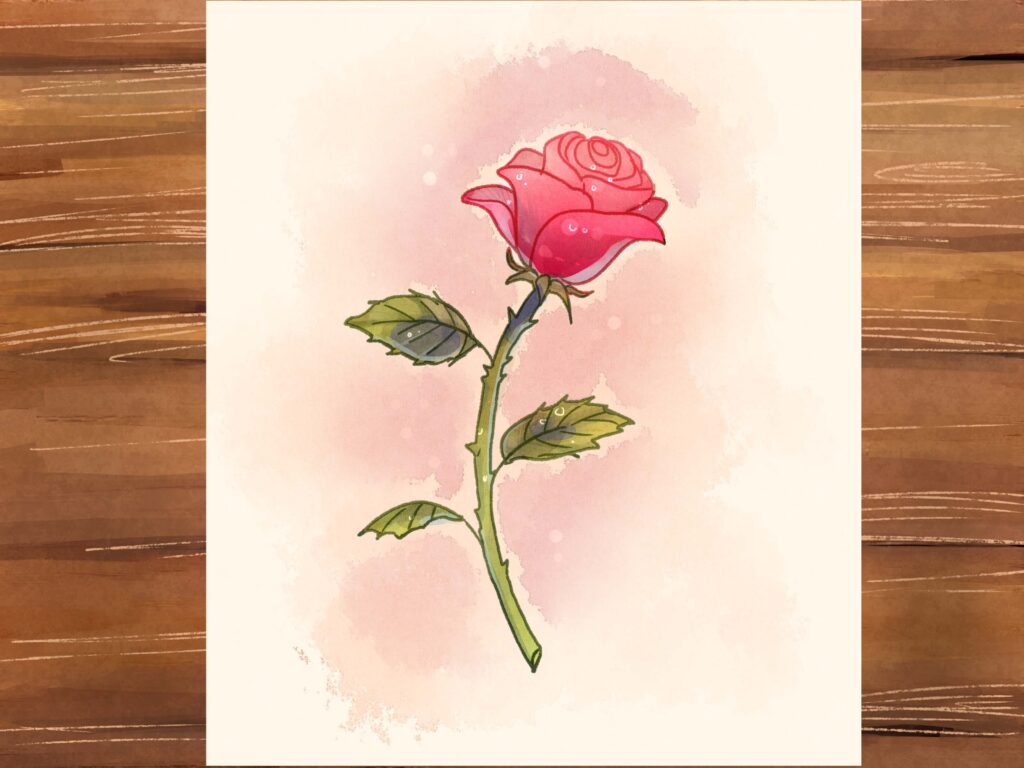Unveiling the Rose: A Step-by-Step Guide and Celebration of this Timeless Bloom
The rose, with its velvety petals and intoxicating fragrance, has captivated hearts for millennia. It’s a universal symbol of love, beauty, and passion, inspiring artists, poets, and everyday admirers alike. If you’ve ever longed to capture this iconic flower on paper, fret no more! This comprehensive guide will equip you with the knowledge and techniques to draw a beautiful rose, step by step.
Before You Bloom: Essential Materials
To embark on your artistic journey, gather these tools:
- Drawing Paper: Opt for smooth, medium-weight paper that allows for blending and layering.
- Pencils: A range of pencils (HB, 2B, 4B) for sketching and shading.
- Eraser: A kneaded eraser for gentle lifting and a vinyl eraser for more precise corrections.
- Sharpener: Keep your pencils sharp for clean lines.
- Drawing Pen (Optional): A fine-tipped pen for outlining (gel pens or micron pens work well).
- Colored Pencils or Paints (Optional): To add vibrant hues to your rose.
Let’s Get Drawing: A Step-by-Step Guide
Now that you’re armed with the necessary tools, let’s delve into the creation process:
Step 1: Sketching the Foundation
- Start with Light Lines: Begin with an HB pencil and light strokes. Draw a small oval in the center of your paper to represent the rose’s bud.
- Building the Layers: Around the initial oval, sketch larger, looser ovals to depict the outer petals. Overlap these slightly to create a sense of depth. Don’t worry about perfect symmetry; roses are naturally uneven!
- Stem and Leaves: From the base of the bud, draw a straight line downwards for the stem. Add a few curved lines branching off the stem to represent leaves.
Step 2: Refining the Form
- Define the Petals: Using a 2B pencil, refine the shapes of the petals. Add gentle curves and points to create a more realistic form. Remember, rose petals aren’t perfectly smooth; they have subtle folds and wrinkles.
- Shaping the Stem and Leaves: Thicken the stem with additional light pencil strokes. Refine the leaf shapes and add details like veins with short, delicate lines.
Step 3: Adding Depth with Shading
- Shadow Play: Identify the light source (imaginary or real). Areas facing the light will be lighter, while those facing away will be in shadow. Use your 2B or 4B pencil to shade the areas away from the light source on the rose petals, stem, and leaves. Apply lighter shading for gradual transitions and darker tones for deeper shadows.
- Layering for Dimension: Build up the shading gradually, layering multiple light passes to create smooth transitions and depth.
Step 4: Highlighting and Details
- Light Touches: Use your HB pencil or a white gel pen to add highlights on the petals facing the light source. This creates a sense of realism and emphasizes the three-dimensionality of the rose.
- Finishing Touches: Refine any details you might have missed. You can add subtle texture to the petals with short, light pencil strokes.
Step 5: Beyond the Pencil :
- Inking: If you used a pencil sketch, carefully outline your drawing with a fine-tipped pen. Once the ink dries, erase the pencil lines for a clean finish.
- A Splash of Color: Breathe life into your rose with colored pencils or paints. Experiment with different shades of red, pink, yellow, or even orange to create a unique color palette.
Remember: This is just a basic guide. Feel free to experiment, add details like thorns, or adjust the number of petals to create your own artistic interpretation of the rose.
Frequently Asked Questions about Drawing Roses
Q: How can I make my rose look more realistic?
- Observe Real Roses: Pay close attention to the natural variations in petal shapes, folds, and color gradients. Studying real roses or high-quality photographs can significantly improve your drawing.
- Practice Shading Techniques: Mastering shading is key to creating depth and realism. Experiment with different pencil pressures and layering techniques to achieve smooth transitions between light and shadow.
- Don’t Be Afraid to Make Mistakes: Embrace the learning process. Mistakes are opportunities to refine your technique. Use your eraser strategically and don’t be discouraged if your first attempt isn’t perfect.
Q: What are some good reference resources for drawing roses?
- Botanical Illustrations: Libraries and online resources often offer.
The Rose: A Celebration Beyond the Page
The rose transcends the realm of drawing paper. It has permeated cultures and traditions for centuries, leaving behind a fragrant trail of symbolism and beauty. Here’s a glimpse into the multifaceted world of the rose:
-
A Timeless Symbol: The rose’s symbolic meaning varies depending on its color. Red roses embody passionate love and desire, while white roses represent purity and innocence. Pink roses express affection, gratitude, and admiration. Yellow roses symbolize friendship and joy.
-
A Global Bloom: Roses have captivated cultures worldwide. In ancient Greece, they were associated with Aphrodite, the goddess of love. In China, roses represent beauty, love, and good luck. In Islamic cultures, the rose is seen as a symbol of perfection and divine love.
-
Aromatic Allure: The rose’s intoxicating fragrance has been prized for centuries. Rosewater, derived from rose petals, is used in perfumes, cosmetics, and culinary delights like Turkish delight. The essential oil extracted from roses is a prized ingredient in high-end perfumes.
-
A Culinary Canvas: Rose petals aren’t just for aesthetics; they’re also edible! Rose-infused jams, jellies, and teas are culinary delicacies enjoyed worldwide. Rosewater adds a subtle floral touch to desserts and beverages.
-
The Art of Cultivation: Growing roses requires patience and dedication. From choosing the right variety to proper pruning and care, cultivating these beautiful blooms is an art form in itself. Rose gardens serve as havens of beauty and fragrance, attracting visitors and sparking joy.
-
A Rosy Future: Roses continue to inspire artists, designers, and scientists alike. Rose breeders develop new varieties with unique colors, shapes, and fragrances. Rose research delves into the flower’s medicinal properties, exploring potential health benefits.
In conclusion, the rose is more than just a beautiful flower. It’s a cultural icon, a source of inspiration, and a symbol of love, beauty, and resilience. Whether you capture its essence on paper, cultivate it in your garden, or savor its fragrance, the rose offers a timeless connection to the natural world and the human spirit. So, the next time you encounter a rose, take a moment to appreciate its multifaceted beauty and the rich tapestry of stories it weaves.



